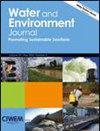Applications of integrated response surface methodology statistic techniques and artificial neural network‐based machine learning to optimize residual chlorine production and energy consumption
IF 1.8
4区 环境科学与生态学
Q4 ENVIRONMENTAL SCIENCES
引用次数: 0
Abstract
A multifactor interaction study was performed using the combined response surface methodology and an artificial neural network on the operational parameters and their influence on residual chlorine production. The operating variables, sodium chloride concentration, electrical potential, electrolysis time, and electrode gap, were evaluated over the response, residual chlorine and energy consumption. The results indicated that the optimum value for residual chlorine was 2450 mg/L achieved at an electrical potential of 8.8 V for 25 min in the presence of 25 g/L of sodium chloride and an electrode distance of 1 cm, and the optimum corresponding energy consumption was measured at 21.76 kWh/L. The study reveals that electric potential, sodium chloride concentration, and electrolysis time positively influence residual chlorine production. ANN models showed superior prediction ability compared with RSM models. This suggests electrolysis can be used for active chlorine production from saline solutions, potentially for industrial applications and water disinfection.综合响应面方法统计技术和基于人工神经网络的机器学习在优化余氯生产和能源消耗中的应用
采用响应面法和人工神经网络对运行参数及其对余氯产量的影响进行了多因素交互研究。评估了氯化钠浓度、电势、电解时间和电极间隙等操作变量对余氯和能耗的影响。结果表明,在氯化钠浓度为 25 克/升、电极间距为 1 厘米、电位为 8.8 伏、电解时间为 25 分钟的条件下,余氯的最佳值为 2450 毫克/升,相应的最佳能耗为 21.76 千瓦时/升。研究表明,电势、氯化钠浓度和电解时间对余氯产量有积极影响。与 RSM 模型相比,ANN 模型显示出更优越的预测能力。这表明电解法可用于从盐溶液中生产活性氯,有可能用于工业应用和水消毒。
本文章由计算机程序翻译,如有差异,请以英文原文为准。
求助全文
约1分钟内获得全文
求助全文
来源期刊

Water and Environment Journal
环境科学-湖沼学
CiteScore
4.80
自引率
0.00%
发文量
67
审稿时长
18-36 weeks
期刊介绍:
Water and Environment Journal is an internationally recognised peer reviewed Journal for the dissemination of innovations and solutions focussed on enhancing water management best practice. Water and Environment Journal is available to over 12,000 institutions with a further 7,000 copies physically distributed to the Chartered Institution of Water and Environmental Management (CIWEM) membership, comprised of environment sector professionals based across the value chain (utilities, consultancy, technology suppliers, regulators, government and NGOs). As such, the journal provides a conduit between academics and practitioners. We therefore particularly encourage contributions focussed at the interface between academia and industry, which deliver industrially impactful applied research underpinned by scientific evidence. We are keen to attract papers on a broad range of subjects including:
-Water and wastewater treatment for agricultural, municipal and industrial applications
-Sludge treatment including processing, storage and management
-Water recycling
-Urban and stormwater management
-Integrated water management strategies
-Water infrastructure and distribution
-Climate change mitigation including management of impacts on agriculture, urban areas and infrastructure
 求助内容:
求助内容: 应助结果提醒方式:
应助结果提醒方式:


